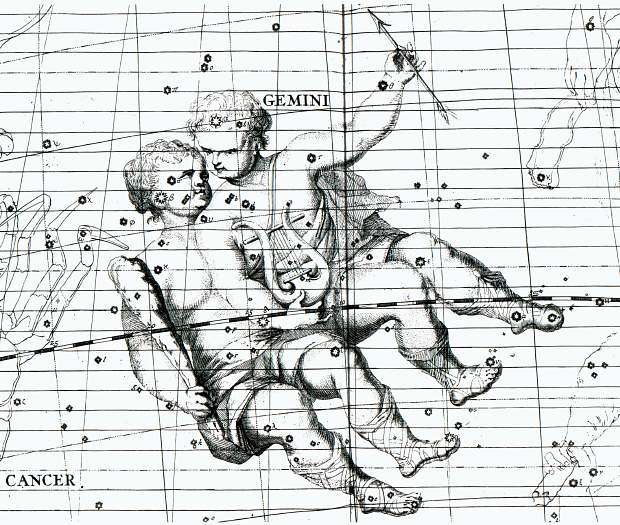

Gemini represents the twins Castor and Polydeuces (Pollux is the Latin form of his name); they were known to the Greeks as the Dioscuri, literally meaning ‘sons of Zeus’. However, mythologists disputed whether both really were sons of Zeus, because of the unusual circumstances of their birth. Their mother was Leda, Queen of Sparta, whom Zeus visited one day in the form of a swan (now represented by the constellation Cygnus). That same night she also slept with her husband, King Tyndareus. Both unions were fruitful, for Leda subsequently gave birth to four children. In the most commonly accepted version, Polydeuces and Helen (later to become famous as Helen of Troy) were children of Zeus, and hence immortal, while Castor and Clytemnestra were fathered by Tyndareus, and hence were mortal.
Castor and Polydeuces grew up the closest of friends, never quarrelling or acting without consulting each other. They were said to look alike and even to dress alike, as identical twins often do. Castor was a famed horseman and warrior who taught Heracles to fence, while Polydeuces was a champion boxer.
The inseparable twins joined the expedition of Jason and the Argonauts in search of the golden fleece. The boxing skills of Polydeuces came in use when the Argonauts landed in a region of Asia Minor ruled by Amycus, a son of Poseidon. Amycus, the world’s greatest bully, would not allow visitors to leave until they had fought him in a boxing match, which he invariably won. He stamped down to the shore where the Argo lay and challenged the crew to put up a man against him. Polydeuces, stirred by the man’s arrogance, accepted at once and the two pulled on leather gloves. Polydeuces easily avoided the rushes of his opponent, like a matador side-stepping a charging bull, and felled Amycus with a blow to the head that splintered his skull.
On the Argonauts’ homeward trip with the golden fleece Castor and Polydeuces were of further value to the crew. Apollonius Rhodius tells us briefly that during the voyage from the mouth of the Rhone to the Stoechades Islands (the present-day Iles d’Hyères off Toulon) the Argonauts owed their safety to Castor and Polydeuces. Presumably a storm was involved, but he does not elaborate on the circumstances. Ever since this episode, says Apollonius – and he assures us there were other voyages on which they were saviours – the twins have been the patron saints of sailors. Hyginus said that the twins were given the power to save shipwrecked sailors by Poseidon, the sea god, who also presented them with the white horses that they often rode.
Mariners believed that during storms at sea the twins appeared in a ship’s rigging in the form of the electrical phenomenon known as St Elmo’s fire, as described by Pliny, the Roman writer of the first century AD, in his book Natural History:
On a voyage stars alight on the yards and other parts of the ship. If there are two of them, they denote safety and portend a successful voyage. For this reason they are called Castor and Pollux, and people pray to them as gods for aid at sea.
A single glow was called Helen and was considered a sign of disaster.
Castor and Polydeuces clashed with another pair of twins, Idas and Lynceus, over two beautiful women. Idas and Lynceus (who were also members of the Argo’s crew) were engaged to Phoebe and Hilaira, but Castor and Polydeuces carried them off. Idas and Lynceus gave pursuit and the two sets of twins fought it out. Castor was run through by a sword thrust from Lynceus, whereupon Polydeuces killed him. Idas attacked Polydeuces but was repulsed by a thunderbolt from Zeus.
Another story says that the two pairs of twins made up their quarrel over the women, but came to blows over the division of some cattle they had jointly rustled. Whatever the case, Polydeuces grieved for his fallen brother and asked Zeus that the two should share immortality. Zeus placed them both in the sky as the constellation Gemini, where they are seen in close embrace, inseparable to the last.
Aratus referred to the constellation only as the twins, without identifying who they were, but a century later Eratosthenes named them as Castor and Polydeuces. An alternative view, reported by Hyginus, says that the constellation represents Apollo and Heracles, both sons of Zeus but not twins. Ptolemy supported this interpretation; the stars that we know as Castor and Pollux he called ‘the star of Apollo’ and ‘the star of Heracles’. This identification is found not in Ptolemy’s famous Almagest but in a more obscure treatise called Tetrabiblos, about astrology. Several star maps personify the twins as Apollo and Heracles; on the illustration shown here, for example, one twin is depicted holding a lyre and arrow, attributes of Apollo, while the other carries a club, as did Heracles.
The two brightest stars in the constellation, marking the heads of the twins, are named Castor and Pollux. Astronomers have found that Castor is actually a complex system of six stars linked by gravity, although to the eye they appear as one. Pollux is an orange giant star. Unlike the twins that they represent, the stars Castor and Pollux are not related since they lie at different distances from us. Eta Geminorum is called Propus, meaning ‘forward foot’ in Greek, a name that first appears with Eratosthenes.
In Chinese astronomy, Castor and Pollux plus nearby Rho Geminorum formed Beihe, the Northern River – the Southern River, Nanhe, was to be found in Canis Minor, incorporating Procyon and two other stars. Beihe and Nanhe lay north and south of the ecliptic respectively, so the pair were also interpreted as gates or sentries. Either side of Beihe were Jishui and Jixin, each marked by a single star (probably Omicron and Phi Geminorum respectively), representing a supply of water for winemaking and a store of wood. A chain of five stars from Kappa to Theta Geminorum was Wuzhuhou, five lords or princes who acted as the Emperor’s advisors and teachers, among them the astronomer royal. Delta Geminorum was one of a triangle of stars on the ecliptic forming Tianzun, a wine cup or water jar with three feet.
The largest part of present-day Gemini was taken up by Jing, representing a well, which consisted of eight stars: Lambda, Zeta, 36, Epsilon, Xi, Gamma, Nu and Mu Geminorum. They form a shape resembling that of the Chinese character meaning ‘well’. The 22nd Chinese lunar mansion was named Jing after this constellation; it is the widest of the 28 mansions, extending for 33 degrees, greater even than one of the 12 western houses of the zodiac which were all 30 degrees wide.
Teksti täältä. Kuvat google kuvahaku.
-Oola.







Tsek blogini, haastetta sun suunnalle! :)
VastaaPoista